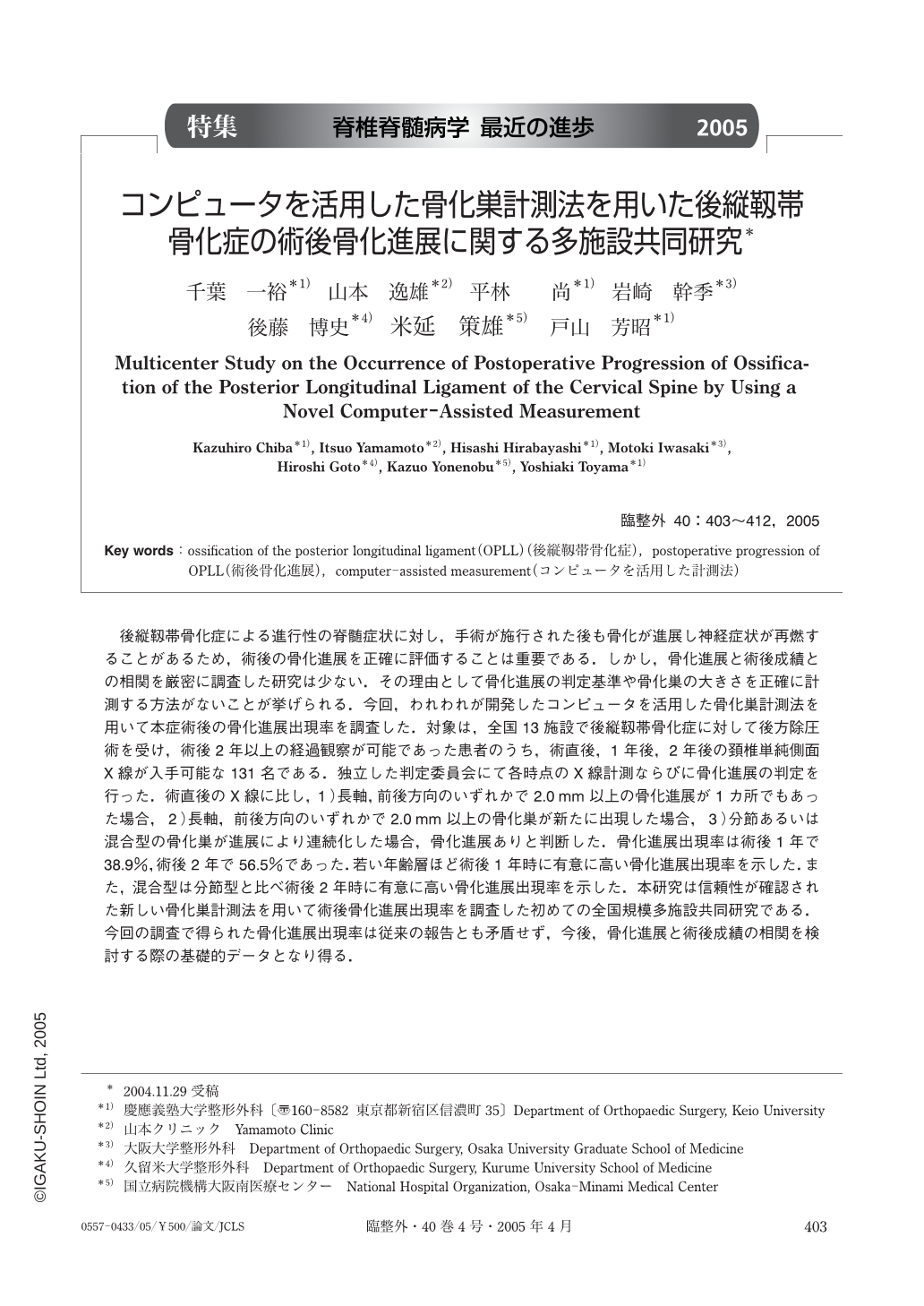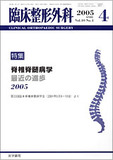Japanese
English
- 有料閲覧
- Abstract 文献概要
- 1ページ目 Look Inside
後縦靱帯骨化症による進行性の脊髄症状に対し,手術が施行された後も骨化が進展し神経症状が再燃することがあるため,術後の骨化進展を正確に評価することは重要である.しかし,骨化進展と術後成績との相関を厳密に調査した研究は少ない.その理由として骨化進展の判定基準や骨化巣の大きさを正確に計測する方法がないことが挙げられる.今回,われわれが開発したコンピュータを活用した骨化巣計測法を用いて本症術後の骨化進展出現率を調査した.対象は,全国13施設で後縦靱帯骨化症に対して後方除圧術を受け,術後2年以上の経過観察が可能であった患者のうち,術直後,1年後,2年後の頚椎単純側面X線が入手可能な131名である.独立した判定委員会にて各時点のX線計測ならびに骨化進展の判定を行った.術直後のX線に比し,1)長軸,前後方向のいずれかで2.0mm以上の骨化進展が1カ所でもあった場合,2)長軸,前後方向のいずれかで2.0mm以上の骨化巣が新たに出現した場合,3)分節あるいは混合型の骨化巣が進展により連続化した場合,骨化進展ありと判断した.骨化進展出現率は術後1年で38.9%,術後2年で56.5%であった.若い年齢層ほど術後1年時に有意に高い骨化進展出現率を示した.また,混合型は分節型と比べ術後2年時に有意に高い骨化進展出現率を示した.本研究は信頼性が確認された新しい骨化巣計測法を用いて術後骨化進展出現率を調査した初めての全国規模多施設共同研究である.今回の調査で得られた骨化進展出現率は従来の報告とも矛盾せず,今後,骨化進展と術後成績の相関を検討する際の基礎的データとなり得る.
Purpose:OPLL often progresses after surgery, and the progression may result in late neurological deterioration. However, few studies has been conducted to elucidate correlations between progression and clinical outcome, in part due to the absence of a clear definition of progression and reliable method of detecting progression. A multicenter study was conducted to investigate the occurrence of postoperative progression and to identify possible risk factors for progression in a large-scale patient population by using a novel computer-assisted measurement method that we developed and validated to provide useful information for future studies.
Methods:Plain lateral radiographs of 131 patients taken immediately, 1, 2 and 5 years after posterior decompression surgery at 13 institutions were analyzed. The films were converted into digital images with a scanner, and the length and thickness of the ossifications were measured with a new computer-assisted measurement method to determine whether progression had occurred. Progression of ossification was defined as 1)an increase of 2 mm or more in the size of any existing lesions, at any level, in any direction;2)the presence of a new lesion measuring 2 mm or more;and 3)bridging between separate lesions to form a continuous lesion. Odds for progression in different age groups and for different types of OPLL were compared to identify possible risk factors.
Results:The rate of occurrence of postoperative progression was 38.9% at 1 year after surgery, 56.5% at 2 years, and 77.3% at 5 years. The rate of occurrence at 5 years postoperatively was estimated to be 71.0% by Kaplan-Meier analysis. Progression at 1 year postoperatively was more frequent in younger patiens than in older patients. The rank of occurrence of progression at 2 years postoperatively was significantly higher in patients with mixed-type than OPLL with the segmental type.
Conclusions:This is the first nationwide multicenter study to investigate the occurrence of progression of OPLL after posterior decompression by a validated, standardized method. The rate of occurrence of postoperative progression of 56.5% at 2 years was comparable to the results of other studies. Younger age and mixed-type OPLL were significant risk factors for progression at 1 and 2 years postoperatively. The results of the present study should serve as a basis for future studies to elucidate correlations between degree of progression and clinical outcome.

Copyright © 2005, Igaku-Shoin Ltd. All rights reserved.


